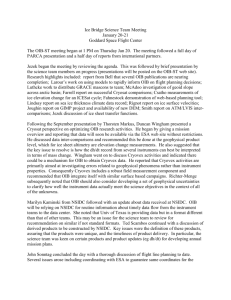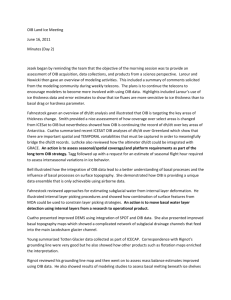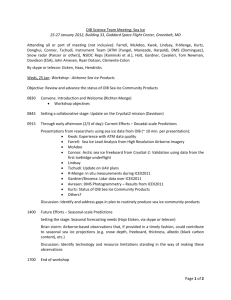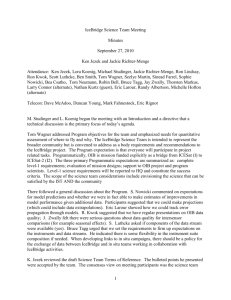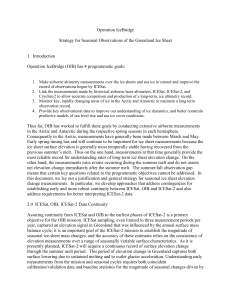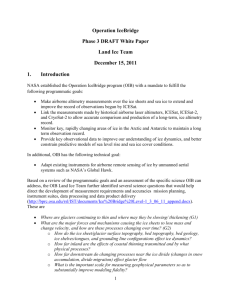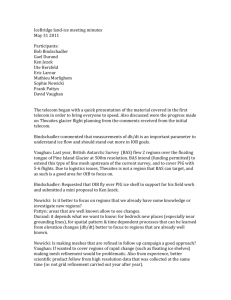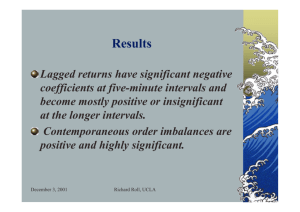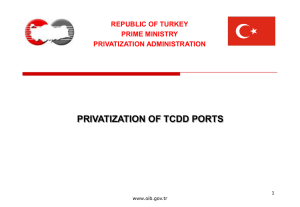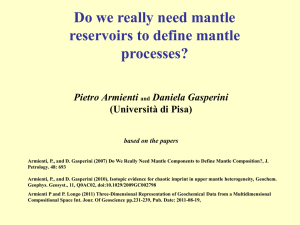Operation Icebridge Meeting LI Minutes Day 1
advertisement
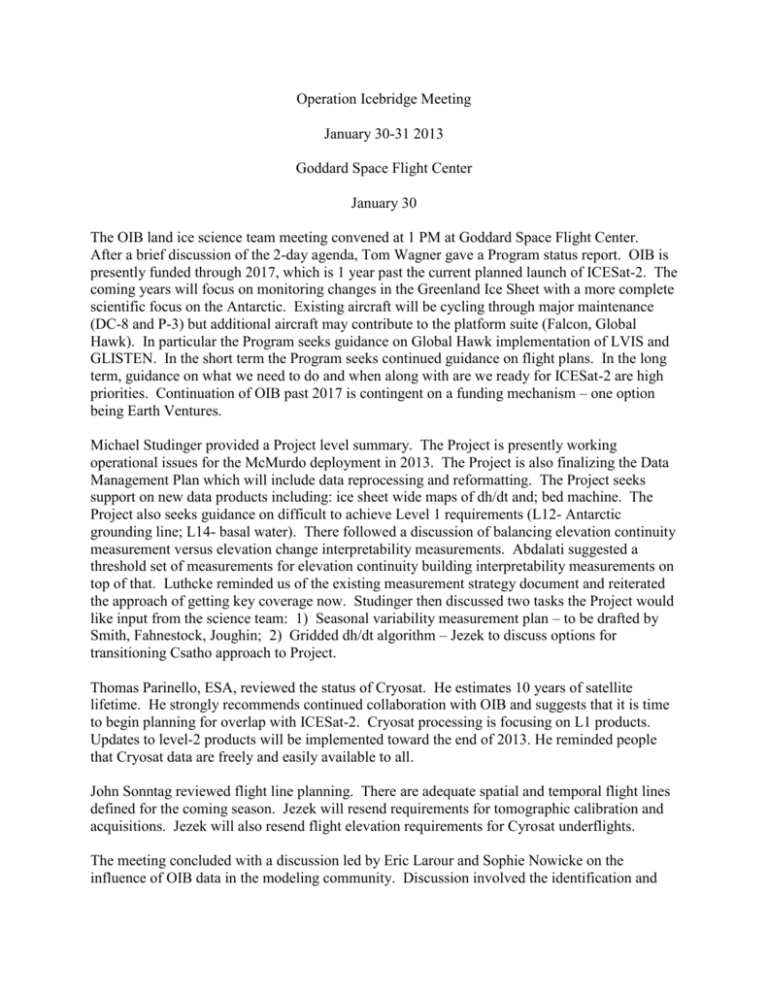
Operation Icebridge Meeting January 30-31 2013 Goddard Space Flight Center January 30 The OIB land ice science team meeting convened at 1 PM at Goddard Space Flight Center. After a brief discussion of the 2-day agenda, Tom Wagner gave a Program status report. OIB is presently funded through 2017, which is 1 year past the current planned launch of ICESat-2. The coming years will focus on monitoring changes in the Greenland Ice Sheet with a more complete scientific focus on the Antarctic. Existing aircraft will be cycling through major maintenance (DC-8 and P-3) but additional aircraft may contribute to the platform suite (Falcon, Global Hawk). In particular the Program seeks guidance on Global Hawk implementation of LVIS and GLISTEN. In the short term the Program seeks continued guidance on flight plans. In the long term, guidance on what we need to do and when along with are we ready for ICESat-2 are high priorities. Continuation of OIB past 2017 is contingent on a funding mechanism – one option being Earth Ventures. Michael Studinger provided a Project level summary. The Project is presently working operational issues for the McMurdo deployment in 2013. The Project is also finalizing the Data Management Plan which will include data reprocessing and reformatting. The Project seeks support on new data products including: ice sheet wide maps of dh/dt and; bed machine. The Project also seeks guidance on difficult to achieve Level 1 requirements (L12- Antarctic grounding line; L14- basal water). There followed a discussion of balancing elevation continuity measurement versus elevation change interpretability measurements. Abdalati suggested a threshold set of measurements for elevation continuity building interpretability measurements on top of that. Luthcke reminded us of the existing measurement strategy document and reiterated the approach of getting key coverage now. Studinger then discussed two tasks the Project would like input from the science team: 1) Seasonal variability measurement plan – to be drafted by Smith, Fahnestock, Joughin; 2) Gridded dh/dt algorithm – Jezek to discuss options for transitioning Csatho approach to Project. Thomas Parinello, ESA, reviewed the status of Cryosat. He estimates 10 years of satellite lifetime. He strongly recommends continued collaboration with OIB and suggests that it is time to begin planning for overlap with ICESat-2. Cryosat processing is focusing on L1 products. Updates to level-2 products will be implemented toward the end of 2013. He reminded people that Cryosat data are freely and easily available to all. John Sonntag reviewed flight line planning. There are adequate spatial and temporal flight lines defined for the coming season. Jezek will resend requirements for tomographic calibration and acquisitions. Jezek will also resend flight elevation requirements for Cyrosat underflights. The meeting concluded with a discussion led by Eric Larour and Sophie Nowicke on the influence of OIB data in the modeling community. Discussion involved the identification and correction of errors in data sets well prior to the gridding process. For the case of ice radar data, CRESIS may be able to accommodate user feed back on detected errors in a well organized fashion. Generally, Larour and Nowicke concluded that OIB is collecting necessary and appropriate data for modeling purposes. The data are being well received by the modeling community. January 31 A joint science team meeting led off OIB day 2. Bryan Blair discussed recent developments with LVIS and Delwyn Moller reviewed progress with the GLISTEN instrument. W. Krabill discussed new ATM derived products to be sent to NSIDC. John Sonntag provided a brief review of elevation differences between different, more recent ITRF solutions. Tom Neumann updated the team on ICESat-2. He concluded that OIB is fulfilling its mission in support of ICESat to ICESat-2 continuity. Jezek recommended that one of this year’s MABEL flights be an underflight of Cryosat. Neumann said he would consider that. J. Arvesen provided a presentation on DMS digital elevation models. The University of Texas team summarized success in photon counting lidar measurements over a calibration site located at Dome-C. Land ice team discussion continued with a review of preparations for ICESat-2 by B. Smith who illustrated where there were gaps in OIB coverage. The recommendation was to work to fill the gaps with data acquired at least once during OIB. Smith also reviewed several vu-graphs illustrating important elevation change areas identified by Csatho. Along with comments on gap filling from Luthcke a general discussion followed which concluded that there be threshold goals for OIB acquisitions complementary to the acquisition strategy document already produced and published. In essensence 1) OIB will fly a grid pattern the same glacier each season as a threshold (Jacobshavn, Pine Island). 2) OIB will attempt to fill coverage gaps so that regions are sampled at least once during OIB as practical 3) Remaining flight time will be devoted to acquiring data in support of ICESat and ICESat-2 science interpretation (This goal will also likely be fulfilled by activities under item 2). 4) Once time allocations in support of 1-3 are completed remaining time will be used to support other programs unless other programs can be supported by minor changes to OIB flight lines and without compromising annual OIB objectives. At the conclusion of that discussion a successful and interesting assessment of flight line priorities was conducted. At Bell’s recommendation, the team evaluated the ensemble of flight lines in hard copy and quickly produced an acceptable prioritization both on programmatic, scientific and logistical grounds. This approach for sorting priorities seems like a good approach to include during future meetings. Rignot led the follow on discussion of progress toward OIB science requirements. All of the measurement accuracy requirements are largely met in Greenland, Antarctica and Alaska. There was uncertainty about the radiometric accuracy of the ice sounding radar data and CRESIS was asked to inform the team about same. Gaps included identifying more Antarctic glaciers for grid coverage, increasing Greenland OIB elevation coverage (if we ignore ICESat-1 coverage), underestimation of radar ice thickness error and probably unavoidable coverage gaps. There was some regret expressed that gravity was not included on this year’s flights to compensate for thickness and bathymetry coverage. Fahnestock presented material from C. Larson which illustrated good glacier coverage achieved by UAF. The team asked for additional clarification on UAF success in meeting OIB requirements and whether UAF was able to increase spatial coverage last year in response to OIB endorsement of the Larson request. Fahnestock reviewed the need for seasonal studies by illustrating differences in modeled surface melt volume. More details will be forthcoming in the seasonal studies report. M. Kaminski reported on NSIDC activities. There was a suggestion to try and cross link NSIDC OIB and ESA Cryosat and Cryovex data sets. Wu and Paden concluded the meeting with a tomography discussion. An issue is how to do manual picks of ice thickness with cross checking using tomographic data. The alternative is to process all the MCoRDS data with tomographic mode and integrate them with the manual picks. Jezek also called on the engineers to investigate approaches for widening swath width. Wu did initial visual evaluation on some high altitude DC8 Antartica MCoRDS data and estimated that a 8 to 10 km swath is possible in the best cases. Wu and John planned to do some data evaluation using those data. Action Items 1) 2) 3) 4) 5) 6) Seasonal observation strategy (Joughin, Smith, Fahnestock) Elevation Change Algorithm to Project Options (Csatho, Jezek) CRESIS radiometric stability analysis May telecons to prepare for Antarctic Season (Jezek) Investigate options for June Irvine Meeting (Rignot) UAF update on fulfilling OIB science requirements (Larson)
